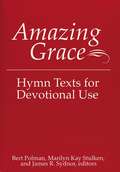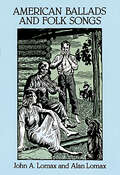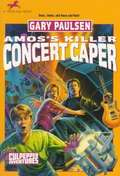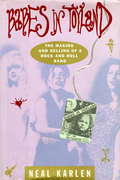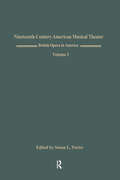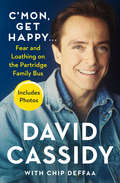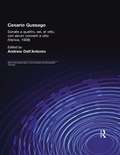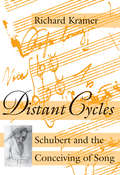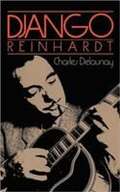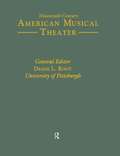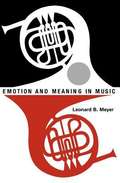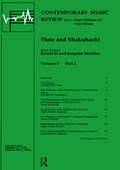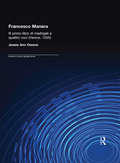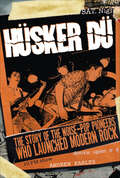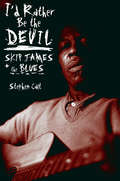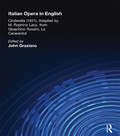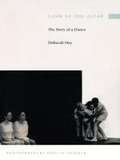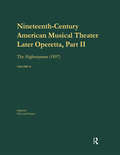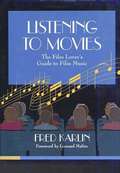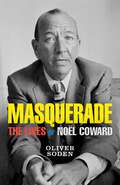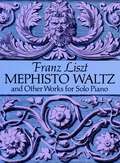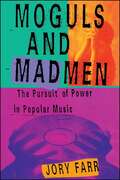- Table View
- List View
Amazing Grace: Hymn Texts for Devotional Use
by Bert Polman Marilyn Kay Stulken James Rawlings SydnorThe editors describe this book as "a hymnal for the home." Words to hymns are written as poetic verses and are organized around such typical worship categories as hope, faith, praise, etc.
American Ballads and Folk Songs (Dover Books on Music)
by John A. Lomax Alan LomaxWith this ample collection of authentic ballads and songs, you can immerse yourself in the rich tradition and heritage of American folk music. Discover the diversity, spontaneity, free-flowing melody, and sheer invention of scores of songs sung by cowboys and convicts, lumberjacks, hobos, miners, plantation slaves, mountaineers, soldiers, and many others.One of the remarkable features of this collection is its authenticity. Many of the songs were recorded "on location" by noted folklorist John A. Lomax and his even more famous son, Alan, as they traveled around the United States. The results are firsthand versions of music and lyrics for over 200 railroad songs, chain-gang songs, mountain songs, Creole songs, cocaine and whisky songs, "reels," minstrel songs, songs of childhood, and a host of others. Among them are such time-honored favorites as "John Henry," "Goin' Home," "Frankie and Albert," "Down in the Valley," "Little Brown Jug," "Alabama-Bound," "Shortenin' Bread," "Skip to My Lou," "Frog Went a-Courtin'," and a host of others. An excellent introduction, notes on each song, a bibliography, and an index round out this extensive and valuable collection.Musician, musicologists, folklorists, singers — anyone interested in American folk music — will welcome this treasury of timeless song gathered in one handy, inexpensive volume.
Amos's Killer Concert Caper
by Gary PaulsenAmos is desperate. He's desperate for two tickets to the romantic event of his young life...the Road Kill concert! He'll do anything to get them because he heard from a friend of a friend of a friend of Melissa Hansen that: she's way into Road Kill.
Babes in Toyland
by Neal KarlenBabes in Toyland is a rare peek into the glamorous and tough world of rock and roll--an exclusive backstage pass for anyone who has ever fantasized about starting a band, being discovered by a major label, recording an album, and touring the country to play music in front of thousands. Also, with its revealing look at the record business--an industry that makes the rest of show business seem positively tame--this book is as immediate as a new issue of Rolling Stone, as colorful as a good mystery, and as tart and explosive as a top-ten hit. Told with the gritty, up-close feel of a behind-the-scenes documentary film, this is the story of three young women who wanted to play rock and roll like the boys. It follows their coming together in the underground grunge-rock scene in Minneapolis, their early club days, and their discovery by Warner Bros. Records. It tracks their dramatic breakup (and reconfiguration), goes through the often funny, sometimes inspiring, and always emotional recording sessions for their album Fontanelle, and goes stage-side as they film their all-important video for MTV. Veteran journalist Neal Karlen was given unprecedented access to Warners marketing and strategy meetings, where he observed firsthand the star-making machinery that runs the pop music business. From punk rockers in the mosh pit to rock stars in mansions, Babes in Toyland contains revealing snapshots of Kurt Cobain and Courtney Love, Soul Asylum's Dave Pirner, Pearl Jam's Eddie Vedder, and R.E.M.'s Michael Stipe, as well as Beavis and Butt-head, today's most powerful rock critics. Center-stage in this story are the members of Babes in Toyland: Kat Bjelland, the punk-rock poetess who'd dreamed of being a star since she was five years old; Lori Barbero, the dreadlocked drummer and band mother who was best friend to everybody in the alternative music scene; and Maureen Herman, the brainy bassist who struggled to fit in with the group. There's also Tim Carr, the Warner Bros. A & R man who saw in the Babes the talent and drive to make it to the top of the grunge scene. Finally, there's Babes in Toyland's triumphant spot on the 1993 Lollapalooza, the most prestigious tour in rock and roll. In this real-life version of The Commitments, readers will also see how success can do more to damage a band of best friends than failure.
British Opera in America: Children in the Wood, Music by Samuel Arnold, Libretto by Thomas Morton, American Premiere Volume I (Nineteenth-Century American Musical Theater Series)
by Susan L. PorterThe series aims to represent all the major genres and styles of musical theater of the century, from ballad opera through melodrama, plays with incidental music, parlor entertainments, pastiche, temperance shows, ethnic theater, minstrelsy, and operetta, to grand opera. This series of sixteen volumes provides for the first time ever a comprehensive set of works from a full century of musical theater in the United States of America. Volume 1 presents the earliest works in this series of Nineteenth-Century American Musical Theater. Indeed, the two tides reprinted here were composed in the prior century but enjoyed a currency in the early 1800s that helped establish conventions for generations of native-born dramaturges and composers. Moreover, Children in the Wood 1795 and Blue Beard 1811 are the only two works included in this series that were fully realized abroad, and imported for performance in the United States by musicians trained in the theaters of London. As editor Susan Porter points out in her Introduction, like all stage works, they were then adapted to suit the tastes of the times and places in which they were performed. (Indeed, Blue Beard was already an English adaptation of a French work.)
C'mon, Get Happy . . .: Fear and Loathing on the Partridge Family Bus
by David Cassidy Chip DeffaaThis memoir by David Cassidy tells the real story behind his phenomenal ’70s stardom—and the sadness that shadowed it. Includes photos and a new afterword. Barely out of his teens, David Cassidy landed a role on a new sitcom about a musical family that toured in a psychedelic bus. The critics blasted it—but TV viewers loved it! And the young female audience especially loved Keith Partridge. Not only did they tune in each week, they bought The Partridge Family’s hit single, “I Think I Love You,” in the millions, and plastered David’s image on their bedroom walls. Throughout the early seventies, David Cassidy was a phenomenon. In this wry, witty memoir, he recounts not only those wild youthful years and Hollywood relationships—with, among others, stepmom Shirley Jones, costar Susan Dey, actress Meredith Baxter, and two guest stars who soon found greater fame on Charlie’s Angels—but also the darker parts of his life as well. David delves into his painful family history and his childhood in West Orange, New Jersey, and the groupies and drugs he indulged in as his success began to overwhelm him. He also shares his encounters with the icons of the era—Lennon and McCartney, Elvis, the Beach Boys, and more. Most of all, he takes us back to a time when the world seemed more innocent—at least until the camera stopped rolling. Includes a new afterword about David’s final years by friend and coauthor Chip Deffaa. “A chatty read about becoming an overnight success and all the trappings that came with it: Tiger Beat magazine, sold-out stadium shows, hit records, willing girls in every hotel lobby.” —Star Tribune
Cesario Gussago. Sonate a quattro, sei, et otti (Italian Instrumental Music of the Sixteenth and Seventeenth Centuries #20)
by Andrew Dell'AntonioFirst Published in 1994. Routledge is an imprint of Taylor & Francis, an informa company.
Distant Cycles: Schubert and the Conceiving of Song
by Richard KramerFranz Schubert's song cycles Schone Mullerin and Winterreise are cornerstones of the genre. But as Richard Kramer argues in this book, Schubert envisioned many other songs as components of cyclical arrangements that were never published as such. By carefully studying Schubert's original manuscripts, Kramer recovers some of these "distant cycles" and accounts for idiosyncrasies in the songs which other analyses have failed to explain. Returning the songs to their original keys, Kramer reveals linkages among songs which were often obscured as Schubert readied his compositions for publication. His analysis thus conveys even familiar songs in fresh contexts that will affect performance, interpretation, and criticism. After addressing problems of multiple settings and revisions, Kramer presents a series of briefs for the reconfiguring of sets of songs to poems by Goethe, Rellstab, and Heine. He deconstructs Winterreise, using its convoluted origins to illuminate its textual contradictions. Finally, Kramer scrutinizes settings from the Abendrote cycle (on poems by Friedrich Schlegel) for signs of cyclic process. Probing the farthest reaches of Schubert's engagement with the poetics of lieder, Distant Cycles exposes tensions between Schubert the composer and Schubert the merchant-entrepreneur.
Distant Cycles: Schubert and the Conceiving of Song
by Richard KramerFranz Schubert's song cycles Schone Mullerin and Winterreise are cornerstones of the genre. But as Richard Kramer argues in this book, Schubert envisioned many other songs as components of cyclical arrangements that were never published as such. By carefully studying Schubert's original manuscripts, Kramer recovers some of these "distant cycles" and accounts for idiosyncrasies in the songs which other analyses have failed to explain. Returning the songs to their original keys, Kramer reveals linkages among songs which were often obscured as Schubert readied his compositions for publication. His analysis thus conveys even familiar songs in fresh contexts that will affect performance, interpretation, and criticism. After addressing problems of multiple settings and revisions, Kramer presents a series of briefs for the reconfiguring of sets of songs to poems by Goethe, Rellstab, and Heine. He deconstructs Winterreise, using its convoluted origins to illuminate its textual contradictions. Finally, Kramer scrutinizes settings from the Abendrote cycle (on poems by Friedrich Schlegel) for signs of cyclic process. Probing the farthest reaches of Schubert's engagement with the poetics of lieder, Distant Cycles exposes tensions between Schubert the composer and Schubert the merchant-entrepreneur.
Dreams of Trespass: Tales of a Harem Girlhood
by Fatima MernissiThis rich, magical and absorbing growing-up tale set in a little-known culture reflects many universals about women. The setting is a "domestic harem"in the 1940s city of Fez, where an extended family arrangement keeps the women mostly apart from society, as opposed to the more stereotypical "imperial harem," which historically provided sex for sultans and other powerful court officials. Moroccan sociologist Mernissi ( Islam and Democracy ) charts the changing social and political frontiers and limns the personalities and quirks of her world. Here she tells of a grandmother who warns that the world is unfair to women, learns of the confusing WW II via radio news in Arabic and French, watches family members debate what children should hear, wonders why American soldiers' skin doesn't reflect Moroccan-style racial mixing and decides that sensuality must be a part of women's liberation. With much folk wisdom--happiness, the author's mother told her, "was when there was a balance between what you gave and what you took"--this book not only tells a winning personal story but also helps to feminize a much-stereotyped religion.
Early Melodrama: The Voice of Nature, Music by Victor Pelisser, Script by William Dunlap, 1803 (Nineteenth-Century American Musical Theater Series)
by Karl Kroeger and Fell Yellin VictorPart of a series of sixteen volumes that provides for the first time ever a comprehensive set of works from a full century of musical theater in the United States of America. Many of the volumes contain musical scores and librettos that have never before been published. The work that leads off this volume, The Voice of Nature, is generally considered the first melodrama to be performed in America, and the earliest surviving complete work composed for American professional theater. It is also the first to be written by a playwright boom in America.
Emotion and Meaning in Music
by Leonard B. Meyer"Altogether it is a book that should be required reading for any student of music, be he composer, performer, or theorist. It clears the air of many confused notions . . . and lays the groundwork for exhaustive study of the basic problem of music theory and aesthetics, the relationship between pattern and meaning."--David Kraehenbuehl, Journal of Music Theory "This is the best study of its kind to have come to the attention of this reviewer."--Jules Wolffers, The Christian Science Monitor "It is not too much to say that his approach provides a basis for the meaningful discussion of emotion and meaning in all art."--David P. McAllester, American Anthropologist "A book which should be read by all who want deeper insights into music listening, performing, and composing."--Marcus G. Raskin, Chicago Review
Flute and Shakuhachi (Contemporary Music Review)
by Kondō Jō Joaquim BernítezFirst Published in 1994. In their quest for new sound materials, avant-garde musicians often produce sounds which accidentally bear a strong resemblance to traditional instruments. While conventional Western instruments have taken on a functional role, instruments such as the shakuhachi are still closely associated with their cultural, religious, and historical roots. The colorful and unique shakuhachi has become the most widely known and used Japanese instrument. This collection provides a comprehensive historical overview of the shakuhachi, its technical aspects and its relationship to the flute.
Francesco Manara: Il primo libro di madrigali a quattro voci (Venice, 1555) (Sixteenth Century Madrigal Series #17)
by Jessie Ann OwensFirst Published in 1994. Routledge is an imprint of Taylor & Francis, an informa company.
Hüsker Dü: The Story of the Noise-Pop Pioneers Who Launched Modern Rock
by Andrew EarlesBob Mould, Grant Hart, and Greg Norton formed Hüsker Dü in 1979 as a wildly cathartic outfit fueled by a cocktail of anger, volume, and velocity. Here's the first book to dissect the trio that countless critics and musicians have cited as one of the most influential bands of the 1980s. Author Andrew Earles examines how Hüsker Dü became the first hardcore band to marry pop melodies with psychedelic influences and ear-shattering volume. Readers witness the band create the untouchable noise-pop of LPs like New Day Rising, Flip Your Wig, and Candy Apple Grey, not to mention the sprawling double-length Zen Arcade. Few bands from the original American indie movement did more to inform the alternative rock styles that breached the mainstream in the 1990s. Hüsker Dü truly were visionaries.
I'd Rather Be the Devil: Skip James and the Blues
by Stephen CaltProviding a clear look into the life of one of the greatest Mississippi bluesmen, this is the first biography of the late Skip James, perhaps the most creative and idiosyncratic of all blues musicians. His 1931 performances of "Devil Got My Woman," "I'm So Glad," and "22-20 Blues" are masterpieces that transcend the genre. Drawing largely on hundreds of hours of conversations with James himself, it paints a dark and unforgettable portrait of a man untroubled by his own murderous inclinations, a man who achieved one moment of transcendent greatness in a life haunted by failure. In doing so, it offers new insights into the nature of the blues, the world in which it thrived, and its fate when that world vanished.
Italian Opera in English: Cinderella, Adapted by M. Rophino Lacy, 1831, from Gioachino Rossini, La Cenerentol (Nineteenth-Century American Musical Theater Series #No. 3)
by M. Rophino LacyFirst Published in 1994. This is volume 3 of a 16-volume series providing comprehensive set of works from a full century of musical theatre in the United States of America. The work in this volume represents Italian opera in English though the works have British origins and strong French influences. This volume discusses various operatic interpretations of the Cinderella story, from its French operatic debut in 1810 to the most famous operas from Perrault and Rossini.
Keep on Singing: A Ballad of Marian Anderson
by Myra Cohn Livingston"When she sang Deep River, One teacher wondered why A tall, calm girl at twilight Should make him want to cry." (The teacher was Arturo Toscanini.) Other books by this American poet are available in this library.
Lamb at the Altar: The Story of a Dance
by Deborah Hay"The intention of my work is to dislodge assumptions about the fixity of the three-dimensional body."--Deborah HayHer movements are uncharacteristic, her words subversive, her dances unlike anything done before--and this is the story of how it all works. A founding member of the famed Judson Dance Theater and a past performer in the Merce Cunningham Dance Company, Deborah Hay is well known for choreographing works using large groups of trained and untrained dancers whose surprising combinations test the limits of the art. Lamb at the Altar is Hay's account of a four-month seminar on movement and performance held in Austin, Texas, in 1991. There, forty-four trained and untrained dancers became the human laboratory for Hay's creation of the dance Lamb, lamb, lamb . . . , a work that she later distilled into an evening-length solo piece, Lamb at the Altar. In her book, in part a reflection on her life as a dancer and choreographer, Hay tells how this dance came to be. She includes a movement libretto (a prose dance score) and numerous photographs by Phyllis Liedeker documenting the dance's four-month emergence.In an original style that has marked her teaching and writing, Hay describes her thoughts as the dance progresses, commenting on the process and on the work itself, and ultimately creating a remarkable document on the movements--precise and mysterious, mental and physical--that go into the making of a dance. Having replaced traditional movement technique with a form she calls a performance meditation practice, Hay describes how dance is enlivened, as is each living moment, by the perception of dying and then involves a freeing of this perception from emotional, psychological, clinical, and cultural attitudes into movement. Lamb at the Altar tells the story of this process as specifically practiced in the creation of a single piece.
Later Operetta 2: the Highwayman, Music by Reginald DeKoven, Libretto by Harry B. Smith, 1897 (Nineteenth-Century American Musical Theater Series)
by Reginald De KovenThe most successful American-born composer of operetta at the end of the nineteenth century was Reginald de Koven. The work reprinted in this volume, The Highwayman, is arguably his best work, although he is better known for the earlier Robin Hoodwixh its evergreen wedding ballad "Oh Promise Me." (Robin Hood is available as a reprint in the 1990 volume American Opera and Music for the Stage, in the G.K. Hall series Three Centuries of American Music.) The editor of this volume, Orly Leah Krasner, is a leading scholar of de Koven’s music. She teaches at the City University of New York, and her Ph.D. dissertation, "Reginald de Koven (1859-1920) and American Comic Opera at the Turn of the Century," is also from that university. Her introduction places the work in the tenor of contemporary critical reaction, and lists the sources available for further study. The Highwayman is one of the few complete operettas of its era for which we are fortunate enough to have original performing materials in the composer’s own hand. As the penultimate volume (number 15) in this series, de Koven’s work of 1897 contrasts with two works of the previous year, Walter Damrosch’s opera The Scarlet Letter (volume 16) and John Philip Sousa’s operetta El Capitan (volume 14).
Listening To Movies: The Film Lover's Guide To Film Music
by Fred KarlinThis text is a lay person's guide to the world of film music, from the silent era to the present day. Oscar-winning film composer Fred Karlin describes how music is written and recorded for the movies; who the composers are and how they work with film makers; and the music itself - what to listen for in a film score, and what makes one score better than another.
Masquerade: The Lives of Noël Coward
by Oliver Soden'This is the biography - truthful, sympathetic and thorough - that Coward deserves'DAILY TELEGRAPHThe voice, the dressing-gown, the cigarette in its holder, remain unmistakable. There is rarely a week when one of Private Lives, Hay Fever, and Blithe Spirit is not in production somewhere in the world. Phrases from Noël Coward's songs - "Mad About The Boy", "Mad Dogs and Englishman" - are forever lodged in the public consciousness. He was at one point the most highly paid author in the world. Yet some of his most striking and daring writing remains unfamiliar. As T.S. Eliot said, in 1954, "there are things you can learn from Noël Coward that you won't learn from Shakespeare".Coward wrote some fifty plays and nine musicals, as well as revues, screenplays, short stories, poetry, and a novel. He was both composer and lyricist for approximately 675 songs. Louis Mountbatten's famous tribute argued that, while there were greater comedians, novelists, composers, painters and so on, only "the master" had combined fourteen talents in one. So central was he to his age's theatre that any account of his career is also a history of the British stage. And so daring was Coward's unorthdoxy in his closest relationships, obliquely reflected throughout his writing, that it must also be a history of sexual liberation in the twentieth century. In Oliver Soden's sparkling, story-packed new Life, the Master finally gets his due.
Max Found Two Sticks
by Brian PinkneyIt was a day when Max didn't feel like talking to anyone. He just sat on his front steps and watched the clouds gather in the sky. A strong breeze shook the tree in front of his house, and Max saw two heavy twigs fall to the ground.
Mephisto Waltz and Other Works for Solo Piano (Dover Classical Piano Music)
by Franz LisztA prolific composer and virtuoso pianist, Franz Liszt (1811-1886) was the most lionized musical personality of his time. His compositions for solo piano continue to be loved and admired by pianists and their audiences for their lush Romanticism and technical fireworks. They remain among the most frequently performed works in the repertoire. This choice selection of Liszt piano works reveals the powers at this extraordinary composer's command: Mephisto Waltz No.1; Nuages Gris; Liebesträume Nos. 1, 2 & 3; Grand Galop Chromatique; Polonaises Nos. 1 & 2; Valse-Impromptu in A-flat Major; Fantasia and Fugue on the Theme BACH; La Lugubre Gondola I & II; Valse Oubliée No. 1; Czárdás Macabre; Gretchen (from A Faust Symphony); Unstern: Sinsitre, Disastro; and Rhapsodie Espagnole.
Moguls And Madmen: The Pursuit of Power in Popular Music
by Jory FarrFrom Simon & Schuster, Moguls and Madmen is Jory Farr's guide to the pursuit of power in popular music. As Jory Farr describes in the prologue of Moguls and Madmen, "this book is not for them [multi millionaire super scouts and corporate executives], however. It's for all the musicians—and the musicians to come—who want to know what they're up against."
